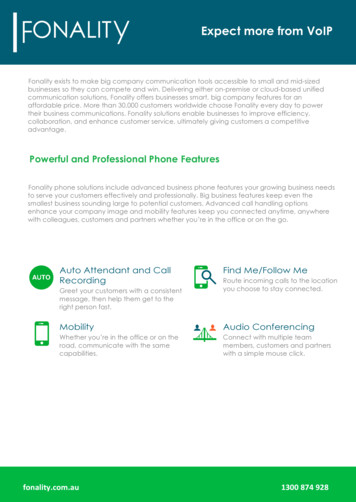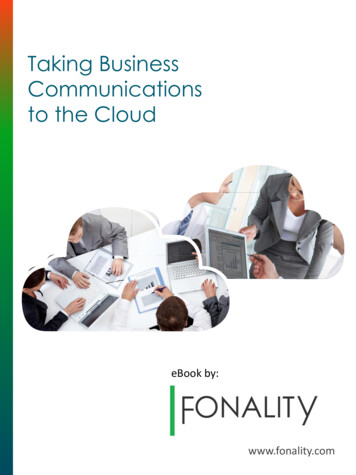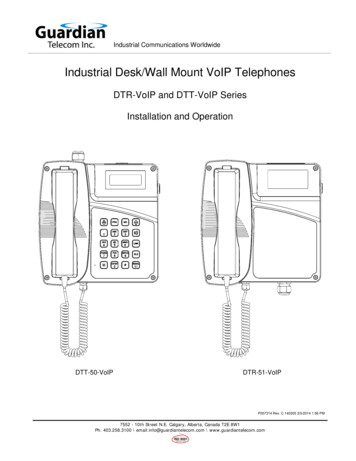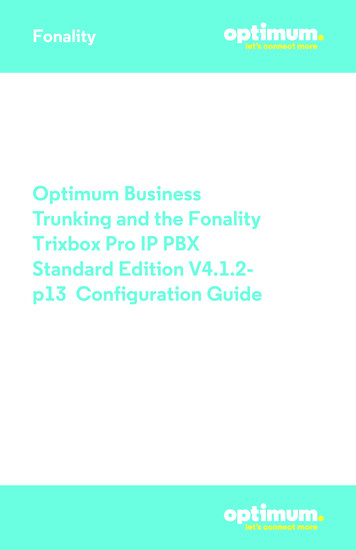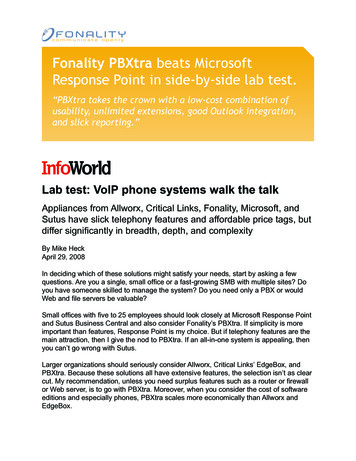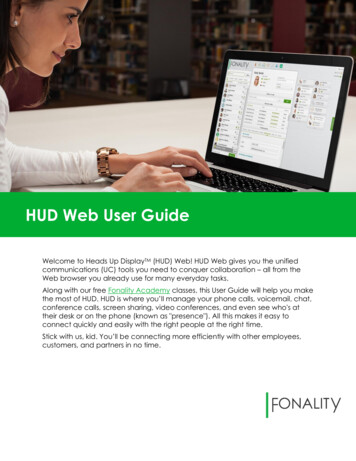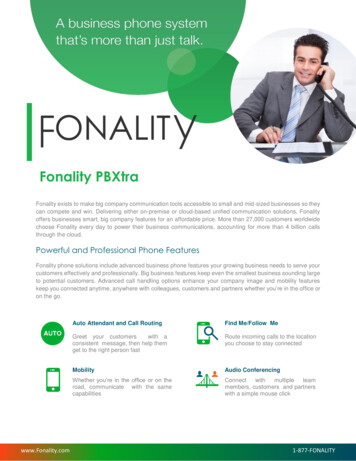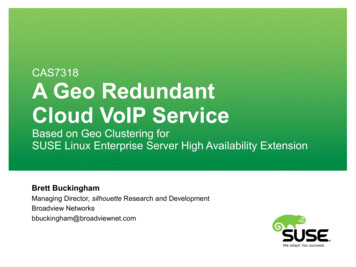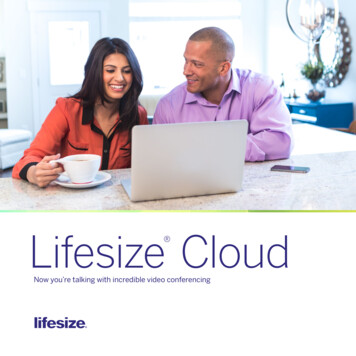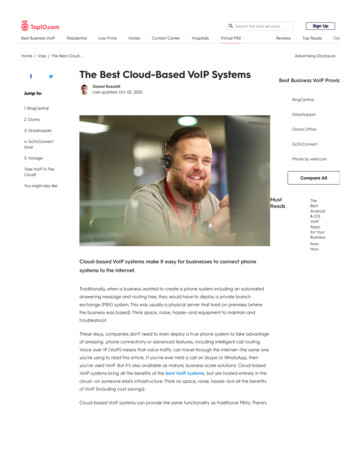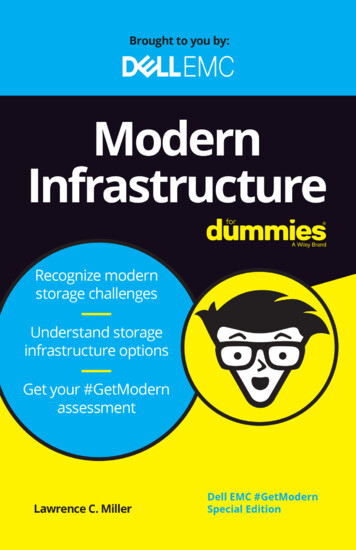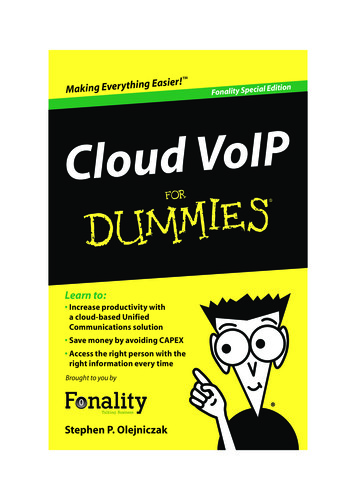
Transcription
g Easier!Making Everythin itionFonality Special EdPIoVduCloLearn to: Increase productivity witha cloud-based UnifiedCommunications solution Save money by avoiding CAPEX Access the right person with theright information every timeBrought to you byStephen P. Olejniczak
Fonality is North America’s fastest growingbusiness communications company and aleading provider of cloud-based VoIP andUnified Communications solutions for smalland mid-size businesses.With a unique software model approach,Fonality provides all the features of legacyproviders without the cost or complexity.Founded in 2004, Fonality has deliveredmore than two billion phone calls acrossthe cloud while enabling more than onemillion users of open-standard-basedcommunications software.Investors include Intel Capital, Draper FisherJurvetson, and Azure Capital Partners.Visit www.fonality.com for moreinformation, or call 877-FONALITY.
Cloud VoIPFORDUMmIES‰FONALITY SPECIAL EDITIONby Stephen P. OlejniczakThese materials are the copyright of John Wiley & Sons, Inc. and anydissemination, distribution, or unauthorized use is strictly prohibited.
Cloud VoIP For Dummies , Fonality Special EditionPublished byJohn Wiley & Sons., Inc.111 River StreetHoboken, NJ 07030-5774Copyright 2011 by John Wiley & Sons., Inc.Published by John Wiley & Sons., Hoboken, NJNo part of this publication may be reproduced, stored in a retrieval system or transmitted in anyform or by any means, electronic, mechanical, photocopying, recording, scanning or otherwise,except as permitted under Sections 107 or 108 of the 1976 United States Copyright Act, without theprior written permission of the Publisher. Requests to the Publisher for permission should beaddressed to the Permissions Department, John Wiley & Sons, Inc., 111 River Street, Hoboken, NJ07030, (201) 748-6011, fax (201) 748-6008, or online at http://www.wiley.com/go/permissions.Trademarks: Wiley, the Wiley Publishing logo, For Dummies, the Dummies Man logo, A Referencefor the Rest of Us!, The Dummies Way, Dummies.com, Making Everything Easier, and related tradedress are trademarks or registered trademarks of John Wiley & Sons, Inc. and/or its affiliates in theUnited States and other countries, and may not be used without written permission. Fonality,Fonality Connect, Fonality Connect , Fonality Heads Up Display, and HUD are unregistered or registered trademark(s) of Fonality, Inc. or its subsidiaries. All other trademarks are the property of theirrespective owners. John Wiley & Sons., Inc., is not associated with any product or vendor mentionedin this book.LIMIT OF LIABILITY/DISCLAIMER OF WARRANTY: THE PUBLISHER AND THE AUTHOR MAKENO REPRESENTATIONS OR WARRANTIES WITH RESPECT TO THE ACCURACY OR COMPLETENESS OF THE CONTENTS OF THIS WORK AND SPECIFICALLY DISCLAIM ALL WARRANTIES,INCLUDING WITHOUT LIMITATION WARRANTIES OF FITNESS FOR A PARTICULAR PURPOSE.NO WARRANTY MAY BE CREATED OR EXTENDED BY SALES OR PROMOTIONAL MATERIALS.THE ADVICE AND STRATEGIES CONTAINED HEREIN MAY NOT BE SUITABLE FOR EVERY SITUATION. THIS WORK IS SOLD WITH THE UNDERSTANDING THAT THE PUBLISHER IS NOTENGAGED IN RENDERING LEGAL, ACCOUNTING, OR OTHER PROFESSIONAL SERVICES. IF PROFESSIONAL ASSISTANCE IS REQUIRED, THE SERVICES OF A COMPETENT PROFESSIONALPERSON SHOULD BE SOUGHT. NEITHER THE PUBLISHER NOR THE AUTHOR SHALL BE LIABLEFOR DAMAGES ARISING HEREFROM. THE FACT THAT AN ORGANIZATION OR WEBSITE ISREFERRED TO IN THIS WORK AS A CITATION AND/OR A POTENTIAL SOURCE OF FURTHERINFORMATION DOES NOT MEAN THAT THE AUTHOR OR THE PUBLISHER ENDORSES THEINFORMATION THE ORGANIZATION OR WEBSITE MAY PROVIDE OR RECOMMENDATIONS ITMAY MAKE. FURTHER, READERS SHOULD BE AWARE THAT INTERNET WEBSITES LISTED INTHIS WORK MAY HAVE CHANGED OR DISAPPEARED BETWEEN WHEN THIS WORK WAS WRITTEN AND WHEN IT IS READ.For general information on our other products and services, please contact our BusinessDevelopment Department in the U.S. at 317-572-3205. For details on how to create a custom ForDummies book for your business or organization, contact info@dummies.biz. For informationabout licensing the For Dummies brand for products or services, contact BrandedRights&Licenses@Wiley.com.ISBN: 978-1-118-13067-4Manufactured in the United States of America10 9 8 7 6 5 4 3 2 1These materials are the copyright of John Wiley & Sons, Inc. and anydissemination, distribution, or unauthorized use is strictly prohibited.
Table of ContentsIntroduction . . . . . . . . . . . . . . . . . . . . . . . . . . . . . . . . . . . . . .1How This Book Is Organized . 1Icons Used in This Book . 2Chapter 1: Introducing VoIP . . . . . . . . . . . . . . . . . . . . . . . . .3Understanding VoIP Benefits. 3Software Advances: Providing More Features for VoIP . 7Integrating It All with UC . 11Chapter 2: Exploiting the Cloud . . . . . . . . . . . . . . . . . . . .13Streamlining Communications Costs . 14Leveraging OPEX and Saving CAPEX . 18Accessing Your Communications Matrix from the Web . 20Chapter 3: Realizing the Fonality Advantage . . . . . . . . .21Enjoying a Purpose-Built SMB Solution. 22Creating More Than Simple Telephony Features . 23Integrating Your iPhone or Android . 25Pocketing the Savings. 26Avoiding CAPEX . 27Pulling It All Together. 27Chapter 4: Managing Everything withFonality Heads Up Display (HUD) . . . . . . . . . . . . . . . .31Navigating Fonality HUD . 32Making It Happen with Fonality HUD . 39Using Fonality Contact Center Features . 42Chapter 5: Ten Places Where Fonality Shines . . . . . . . .47Eliminating CAPEX . 47Enterprise-grade Features . 47Gaining Presence Info . 48Using Fonality HUD . 48Changing Voicemail to E-mail . 48Integrating iPhone and Android . 48Transferring Calls . 48Calling from Firefox . 49Exploiting Deal Size Info . 49Tying In to Your CRM . 49These materials are the copyright of John Wiley & Sons, Inc. and anydissemination, distribution, or unauthorized use is strictly prohibited.
Publisher’s AcknowledgmentsWe’re proud of this book and of the people who worked on it. For details on howto create a custom For Dummies book for your business or organization, contactinfo@dummies.biz. For information about licensing the For Dummies brand forproducts or services, contact BrandedRights&Licenses@Wiley.com.Some of the people who helped bring this book to market include the following:Acquisitions, Editorial, andMedia DevelopmentSenior Project Editor: Zoë WykesEditorial Manager: Rev MengleSenior Business DevelopmentRepresentative: Karen HattanCustom Publishing Project Specialist:Michael SullivanComposition ServicesSenior Project Coordinator: Kristie ReesLayout and Graphics: SDJumperProofreader: Jessica KramerSpecial Help from Fonality: Daryl Reva,Product Marketing ManagerPublishing and Editorial for Technology DummiesRichard Swadley, Vice President and Executive Group PublisherAndy Cummings, Vice President and PublisherMary Bednarek, Executive Director, AcquisitionsMary C. Corder, Editorial DirectorPublishing and Editorial for Consumer DummiesKathleen Nebenhaus, Vice President and Executive PublisherComposition ServicesDebbie Stailey, Director of Composition ServicesBusiness DevelopmentLisa Coleman, Director, New Market and Brand DevelopmentThese materials are the copyright of John Wiley & Sons, Inc. and anydissemination, distribution, or unauthorized use is strictly prohibited.
IntroductionThe Internet was destined to be the future of communications since the early 1990s when we were all accessing itvia dial-up modems. The complexity of the system, and theapplications supported by the cloud, have evolved since then,growing in leaps and bounds as eBay, YouTube, Facebook,and Twitter have taken center stage.During the Internet’s growth, there has always been Voiceover Internet Protocol (VoIP). It too started out in thepublic realm as a simple technology that grew. The industryembraced VoIP, refining it, packaging it, and developing it. It’spossible today to use a provider in the Internet for every telecom feature that was once solely offered by a legacy phonesystem that sat in your office.This book covers the basics of VoIP, Unified Communications(UC), and how they have come together to create the newtechnology of Cloud VoIP. Many companies have made it theirmission to develop this technology, one of the leaders beinga Texas-based company named Fonality. This is the pinnacleof evolution of Cloud VoIP, and the basis for this book, CloudVoIP For Dummies, Fonality Special Edition.Note: The naming conventions of legacy and traditional areused throughout this book. Legacy applies to the predecessorfor tangible things like phone systems, and traditional to theforerunner to intangible things such as how we do things, themindset or technology behind it.How This Book Is OrganizedThe five chapters in this book walk you through theconstituent parts that make up Cloud VoIP and UnifiedCommunications. They areThese materials are the copyright of John Wiley & Sons, Inc. and anydissemination, distribution, or unauthorized use is strictly prohibited.
2Cloud VoIP For Dummies, Fonality Special Edition Chapter 1, Introducing VoIP, explains basic VoIP structure and the advantages over traditional telephony interms of bandwidth efficiency and new features. Chapter 2, Exploiting the Cloud, takes a businessminded view of the technology and how it saves money. Chapter 3, Realizing the Fonality Advantage, runsthrough the financial savings and technical advantagesoffered by Fonality. Chapter 4, Managing Everything with Fonality HeadsUp Display (HUD), covers the greatest tool availabletoday for unifying all of your communications, callqueues, voicemail, e-mail, and chat. Chapter 5, Ten Places Where Fonality Shines, runsdown what Fonality can do for you.The chapters are designed to stand alone, so if you alreadyknow everything there is to know about VoIP, you can jumpdirectly to Chapter 3. If you’re already aware of Fonality,Chapter 4 may be the big draw so feel free to choose whereyou start with this book.Icons Used in This BookEvery For Dummies book has small graphics, called icons,sprinkled throughout the margins that call attention to textwe think is worth special attention. Here’s what they mean.These are bits of information that you should keep in the backof your head as you think about Cloud VoIP; they’ll save youtime, money, or hassle.Telecom has a wealth of nitty-gritty details that help explainwhy things work like they do. If you’re an inquiring mind, readthis information and learn a little more.There may be a more efficient way to do something in thecommunications world. When I have a shortcut for you, I tellyou the secret in the paragraph beside this icon.These materials are the copyright of John Wiley & Sons, Inc. and anydissemination, distribution, or unauthorized use is strictly prohibited.
Chapter 1Introducing VoIPIn This Chapter Learning the basics of VoIP Getting the most out of your IP Bandwidth Familiarizing yourself with great VoIP features Collecting it all with Unified Communications (UC)Cloud VoIP is an amazing technology that couldn’t existif it wasn’t for Voice over Internet Protocol (or VoIP asit’s commonly known). That breakthrough freed us from traditional telephony where a single phone line could only carry asingle phone call.VoIP calls are transmitted using the basic Internet Protocol(IP) architecture that makes up the fabric of the World WideWeb. The same IP infrastructure used for e-mails and IM chatsessions is now handling billions of phone calls globally everyday. VoIP has evolved along with the Internet. It’s grown moreefficient, continually achieving higher quality standards whileopening up telecom features to small and mid-size businesses(SMBs) that used to be the sole domain of Fortune 500 companies. This chapter covers the basics of VoIP and how its structure has enabled it to evolve and become the fastest growingtechnology of our time.Understanding VoIP BenefitsVoIP calls look like traditional phone calls at the most basiclevel. There’s a phone on each end and a network of somekind in the middle. A traditional telephony call uses thePublic Switched Telephone Network (PSTN) that gives theThese materials are the copyright of John Wiley & Sons, Inc. and anydissemination, distribution, or unauthorized use is strictly prohibited.
4Cloud VoIP For Dummies, Fonality Special Editioncall its own private bandwidth pipe from end to end. The56 or 64 kbps allocation is established from the originatingphone to the terminating phone for the life of the call, and noother call can traverse that bandwidth during that time.At least, that’s the way it worked for many years. It was agood system, but it didn’t make the most of the infrastructuresupporting the call. The pair of copper wires that each phoneis plugged into can actually support 23 more calls, even withtraditional telephony.The bandwidth within the PSTN was being wasted as well. A64 kbps pipeline was created every time a call was placed.It’s kind of like someone giving you a private two-lane roadwhenever you and a friend want to drive somewhere. It’d bewonderful, but there’s a lot of space in front and behind youon the lane that you simply aren’t using.Maximizing bandwidthEven if you imagined one car on the road for every wordspoken, there’s still a lot of space left. Half of the time, oneperson is listening while the other one talks, so one of thelanes on your private highway is completely empty. Then addin the pauses between words and sentences while you think ofwhat to say next. When you finish, you can see how you stillhave plenty of free space left on the road.Figure 1-1 shows how the traditional telephony call has a rigidconnection from end to end. The entire length and breadth ofthe call is using 64 kbps whether someone is speaking or not.Even the VoIP packets save bandwidthVoIP is built to sample the voice ofthe people speaking by using a software tool called a CODEC (short forCoder-Decoder). There are a varietyof CODECs available, but they fallinto two categories: the standarduncompressed CODEC, or the CODECwith compression. The most commonCODEC with compression allowsfor an 8:1 compression ratio, allowing you to reduce your bandwidthoverhead.These materials are the copyright of John Wiley & Sons, Inc. and anydissemination, distribution, or unauthorized use is strictly prohibited.
Chapter 1: Introducing VoIPPSTN64 kbpsTraditional Telephony CallInternetAudio streamsStandard VoIP CallFigure 1-1: A TDM versus VoIP bandwidth comparison.The standard VoIP call has dashed lines for the audio streamsbecause it doesn’t have any bandwidth reserved for itsuse only. The individual packets of audio pass through theInternet, surrounded by every other VoIP packet as well ase-mails, web browsing commands, and all other varieties of IPtraffic.The packetized nature of VoIP, along with the IP-based architecture in which it operates, gives it a tremendous advantageover traditional telephony. A small business that had 15individual phone lines and an Internet connection for e-mailand web surfing can now combine all of these over a singleInternet connection. The ability to avoid paying roughly 50per line to simply have dial tone and Caller ID (not including local and long distance minutes) from a traditional localexchange carrier like Verizon or AT&T means an annual savings of up to 9,000.These materials are the copyright of John Wiley & Sons, Inc. and anydissemination, distribution, or unauthorized use is strictly prohibited.5
6Cloud VoIP For Dummies, Fonality Special EditionA time-tested technologyVoIP may seem like it burst on the scene a few years ago, butlong-distance carriers have been exploiting the efficiencies ofit for decades before it was released to the public. The handwriting was on the wall in the late 1980s as the Internet beganto evolve into more than a nationwide network of universitiesinto a commercial and social environment.The telecom networks had been using a transmission protocolcalled Signaling System Number 7 (colloquially known as SS7)since the late 1970s. They took much of the structure of thisprotocol and adapted it to an IP environment, hammering outthe kinks of their new VoIP networks. The technology wasleaked out to the public in the late 1990s when the InternetEngineering Task Force published the guidelines for the mostcommon version of VoIP today, the Session Initiation Protocolput forth in RFC 2543.This, and the release of the first open-source VoIP PrivateBranch Exchange, or PBX, software in the same year, allowedanyone to download and build their own very basic phonesystem. The next ten years saw an unprecedented growth inVoIP as it became available to everyone.There were some bumps and bruises along the way, but theindustry learned, grew, and elevated VoIP to the same consistent quality of a normal, legacy telephony call. By 2010, maintaining VoIP quality was easy as most of the long-distancenetworks were gearing much of their networks to VoIP, andeliminating the obstacles that it stumbled on along the way.Every phone call is a little VoIPEvery long-distance carrier in the U.S. now allows its customers direct VoIP access into its networks. Even if a call comes inwith traditional telephony, it probably won’t avoid being converted to VoIP before it reaches the phone that’s receiving it.Long-distance carriers don’t have direct connections to everytelephone in America, much less to every phone in the world.They use a series of underlying carriers to terminate callsto, or from, every active phone on this planet. Many of theseunderlying carriers have other carriers they use as well, to theThese materials are the copyright of John Wiley & Sons, Inc. and anydissemination, distribution, or unauthorized use is strictly prohibited.
Chapter 1: Introducing VoIP7point where there may be four or five different carriers thathandle a phone call from end to end, and more than that if thecall terminates internationally.The phone call you are making is probably converted to VoIP atleast once as it’s sent through the network of your long-distancecarrier. It may be handed off to an underlying carrier as VoIP, orconverted back to traditional telephony before being delivered.Even then, the underlying carrier may convert the call to andfrom VoIP depending on its network needs and on the requirements of the underlying carrier it’s connected to.Every industry has pressure to provide a product with thelowest price at the highest quality; telecom is no different.This pressure is especially true in the case of internationalcalls where the monthly fee on the cable or fiber optic connection between the U.S. and the foreign country is thebi
a Texas-based company named Fonality. This is the pinnacle of evolution of Cloud VoIP, and the basis for this book, Cloud VoIP For Dummies, Fonality Special Edition. Note: The naming conventions of legacy and traditional are used throughout this book. Legacy applies to the predecessor for tangible things like phone systems, and traditional to the
